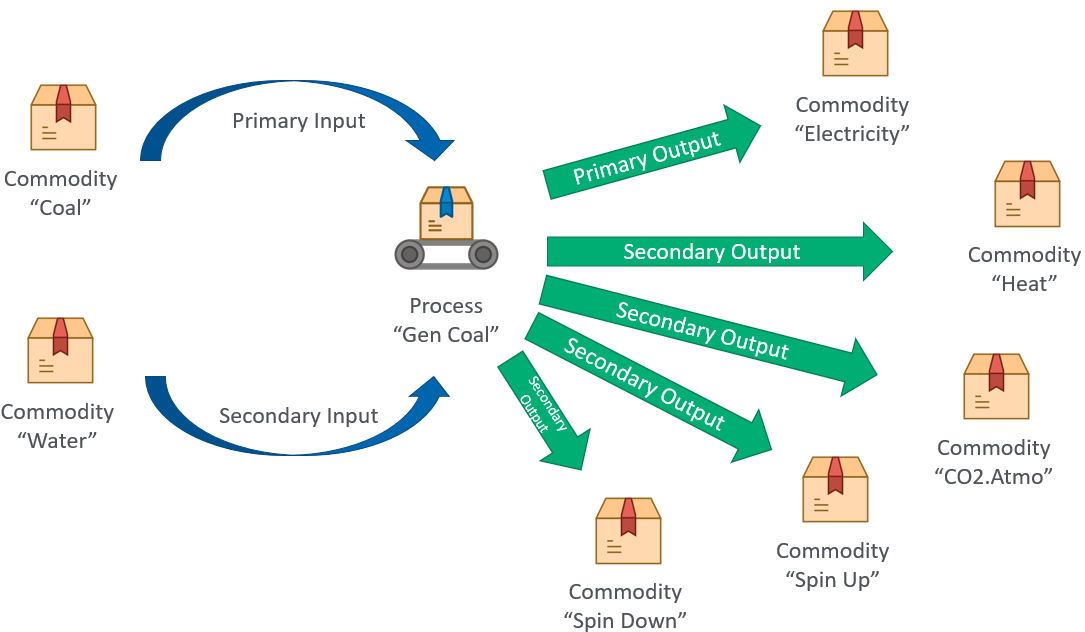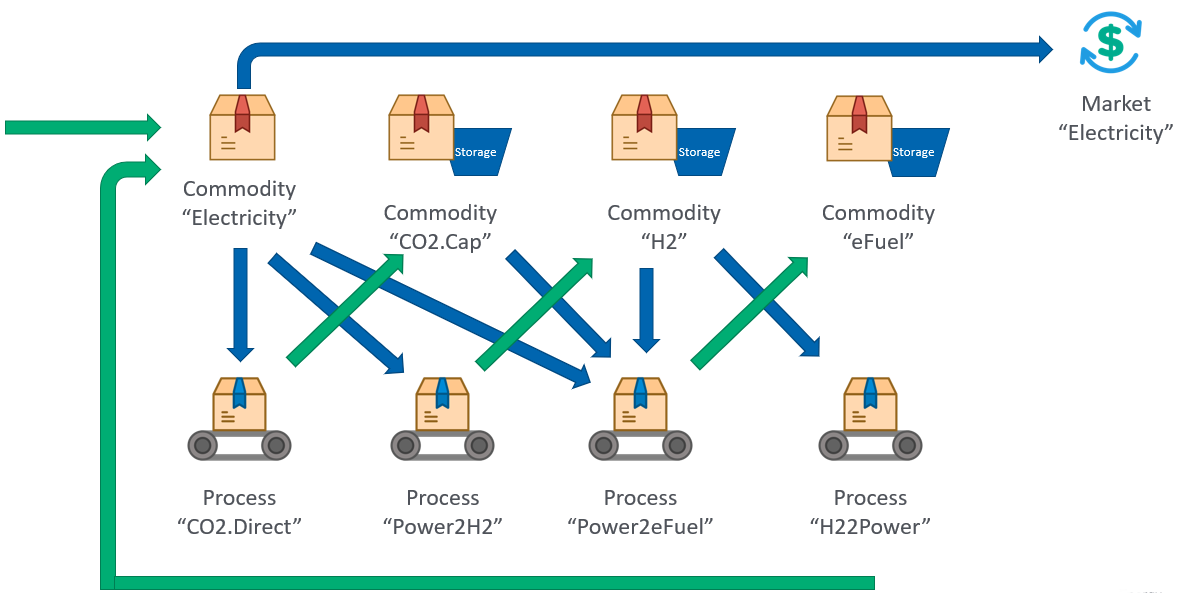Process Class
| Description: | A process that transforms one or more input commodities to one or more output commodities |
See also Process Property Reference for a detailed list of properties for this class of object.
Related Classes: Commodity, Facility.
Overview
A Process takes one or more Commodity inputs and converts them to one or more Commodity outputs. The conversion process has a given Efficiency and (optionally) Capacity. The Efficiency and Capacity properties are based on a Primary Input to Primary Output relationship. Where there are secondary inputs or outputs, their consumption and production is based on ratios of the primary process, rather than having separate efficiencies.
For example, as shown in Figure 1, the process of generating electricity from a fuel consumes a Primary Input Commodity and produces a Primary Output Commodity, in this case "Electricity" and Secondary Outputs "CO2".
You toggle on/off the modeling of a Process with the Units property. A Process may be 'floating' or 'attached'. Floating Process objects exist on their own and are not associated with any physical location or Facility. Attached Process objects are linked to one or more Facility objects. When a Process is attached to a Facility there are additional technical constraints and costs that can be applied. Note that a Process can be implemented by any number of Facility objects.

Figure 1: Example Electricity Generation Process
How to Use Process
The following guide will help you get started using the Process class:
- First create the Commodity objects that your Process will consume and produce.
- Decide which Commodity will be the Primary Input and which will be the Primary Output.
- If all commodities involved are energy types, or you can provide an Energy Density for them, then the simulator will have enough information to convert between commodities automatically and you need only provide the Process Efficiency. For other processes define the Conversion Factor between the commodities.
- Optionally attach the Process to one or more Facility objects that implement that same Process. This allows the definition of additional constraints and efficiency parameters related to how the process performs at a given Facility such as ramp constraints.

Figure 2: Interlinked Processes and Commodities
Examples
Table 1 provides several examples of Process objects and descriptions of their intended purpose. Table shows the memberships that form an electricity generation type of process with secondary outputs of emissions and spinning reserves. Table 3 shows memberships for the conversion of power to hydrogen with inputs of electricity and water and output of hydrogen. Table 4 shows example properties for the electricity generation Process and Table 5 the same for the power to hydrogen Process. Note the use of Operating Minimum Coefficient , Operating Capacity Coefficient, and Unit Maximum to provide additional constraints on the secondary production of the spinning reserve commodities by the Facility.
| Class | Name | Category | Description |
| Process | Battery.Discharge | Electricity Producers | Battery discharging |
| Process | Gen.Coal | Electricity Producers | Generates Electricity from Coal |
| Process | Gen.Gas.CCGT | Electricity Producers | Generates Electricity from Gas using combined cycle |
| Process | Gen.Gas.CT | Electricity Producers | Generates Electricity from Gas using open cycle |
| Process | Gen.Hydro | Electricity Producers | Generate Electricity from Hydro Storage |
| Process | Gen.PS | Electricity Producers | Generates Electricity from Pumped Storage |
| Process | Gen.Solar | Electricity Producers | Generates Electricity from the Sun |
| Process | Gen.Wind | Electricity Producers | Generates Electricity from Wind |
| Process | H2-Power | Electricity Producers | Generates Electricity from H2 |
| Process | Imports | Electricity Producers | External supply of Electricity |
| Process | Battery.Charge | Electricity Consumers | Battery charging |
| Process | CO2.Direct | Electricity Consumers | Direct air capture of CO2 |
| Process | Exports | Electricity Consumers | Export of Electricity |
| Process | Load.PS | Electricity Consumers | Uses Electricity to Pump to Pumped Storage |
| Process | Power-eFuel | Electricity Consumers | Creates eFuel from Electricity, H2 and CO2 |
| Process | Power-H2 | Electricity Consumers | Creates H2 from Electricity and water |
| Process | Spill.Hydro | Other | Spills energy from Hydro |
| Collection | Parent Name | Child Name | Parent Category | Child Category |
| Process.Primary Input | Gen.Coal | Coal | Electricity Producers | Resources |
| Process.Primary Output | Gen.Coal | Electricity | Electricity Producers | Products |
| Process.Secondary Inputs | Gen.Coal | Water | Electricity Producers | Resources |
| Process.Secondary Outputs | Gen.Coal | CO2.Atmo | Electricity Producers | Emissions |
| Process.Secondary Outputs | Gen.Coal | Heat | Electricity Producers | Emissions |
| Process.Secondary Outputs | Gen.Coal | Spin.Down | Electricity Producers | Products |
| Process.Secondary Outputs | Gen.Coal | Spin.Up | Electricity Producers | Products |
| Facility.Primary Process | Plant.Coal | Gen.Coal | Power | Electricity Producers |
| Collection | Parent Name | Child Name | Parent Category | Child Category |
| Process.Primary Input | Power-H2 | Electricity | Electricity Consumers | Products |
| Process.Primary Output | Power-H2 | H2 | Electricity Consumers | Storage |
| Process.Secondary Inputs | Power-H2 | Water | Electricity Consumers | Resources |
| Facility.Primary Process | Plant.Power-H2 | Power-H2 | H2 | Electricity Consumers |
| Collection | Parent Object | Child Object | Property | Value | Data File | Units |
| Processes | System | Gen.Coal | Efficiency | 37 | % | |
| Processes | System | Gen.Coal | Processing Charge | 5 | $ | |
| Process.Secondary Inputs | Gen.Coal | Water | Ratio | 0.52 | - | |
| Process.Secondary Outputs | Gen.Coal | CO2.Atmo | Ratio | 0.920432432 | - | |
| Process.Secondary Outputs | Gen.Coal | Heat | Ratio | 15.44401544 | - | |
| Process.Secondary Outputs | Gen.Coal | Spin.Down | Ratio | 1 | - | |
| Process.Secondary Outputs | Gen.Coal | Spin.Down | Operating Minimum Coefficient | -1 | - | |
| Process.Secondary Outputs | Gen.Coal | Spin.Up | Ratio | -1 | - | |
| Process.Secondary Outputs | Gen.Coal | Spin.Up | Operating Capacity Coefficient | 1 | - | |
| Process.Secondary Outputs | Gen.Coal | Spin.Up | Unit Maximum | 50 | % |
| Collection | Parent Object | Child Object | Property | Value | Data File | Units |
| Processes | System | Power-H2 | Units | 1 | - | |
| Processes | System | Power-H2 | Efficiency | 70 | % |
Constraints and Objectives
You can define custom constraints on Process via the Constraints membership. The Objectives membership allows you to include Commodity coefficients in your multi-objective optimization problems.